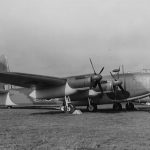Windsor DW512 RAE Farnborough October 1945
Windsor DW506 1944
DW512 powered with Merlin 85 engines in annular cowlings
DW506 during early trials
Type 461 Windsor NK136 in flight
Vickers Type 457, 2nd Prototype at Farnborough 1945
Windsor 2nd prototype DW512
Type 447 Windsor 1st Prototype DW506
Third prototype NK136 with remotely-controlled barbettes with four 20mm cannons
Prototype Vickers 447 DW506 at Farnborough prior to its maiden flight on 23 October 1943
Windsor was a British four-engine, high altitude heavy bomber, designed to Air Ministry Specification B.3/42. Design was heavily based on the Warwick.
One of the requirements originally intended was that the bomber (B.5/41) should have a pressure cabin and cockpit similar to that of the Wellington Mk VI, but this provision was eventually abandoned, so a new specification, B.3/42, was drawn up to cover the revised design of the Windsor, Type 447. By 1943, the Air Ministry committed to an order for 5 prototypes and 300 production aircraft, but by the end of the war only three prototypes had been built:
– first Type 447 DW506, undertook its maiden flight from Farnborough on October 23, 1943, in the hands of Mutt Summers. Initial take-off
weight was restricted to 46,000lb and early performance figures were encouraging with 302mph at 25,000ft recorded. However, the aircraft’s flying was destined to be short-lived because on March 2, 1944, DW506 was damaged beyond repair in a forced landing on Grove airfield, Wantage, and was broken up for component testing.
– DW512, designated as the Type 457, differed by having a set of Merlin 85 engines complete with annular cowlings. It was first flown from Wisley on 15 February, 1944, by Maurice Summers and disclosed a performance almost the same as DW506.
– NK136, designated as the Type 461, initially flew on July 11, 1944. Bomber was fitted with armament after the barbettes were successfully trialled by Warwick L9704.
Vickers Windsor B Mk I (Type 483) – Technical Specifications
This was the production model of the Vickers Windsor, a heavy bomber designed with advanced engine technology and defensive systems.
- Powerplant:
- Four Rolls-Royce Merlin 100 12-cylinder liquid-cooled Vee piston engines.
- Equipped with two-speed, two-stage superchargers for improved high-altitude performance.
- Engines were optimized to deliver peak power at 18,500 feet (5,640 meters).
- Propellers: Rotol four-bladed constant-speed propellers, 12 feet 6 inches (3.81 meters) in diameter.
- Fuel capacity: 2,954 Imperial gallons (13,430 liters), with an additional 626 Imperial gallons (2,845 liters) in auxiliary tanks.
- Performance:
- Maximum speed: 360 mph (580 km/h) at 21,000 feet (6,400 meters), 300 mph (483 km/h) at sea level.
- Cruising speed: 304 mph (489 km/h) at 24,000 feet (7,300 meters).
- Rate of climb: 960 feet per minute (292 meters per minute).
- Time to reach 20,000 feet (6,100 meters): 23.5 minutes.
- Service ceiling: 27,250 feet (8,300 meters).
- Takeoff distance to reach 50 feet (15 meters): 4,350 feet (1,326 meters).
- Range:
- 1,870 miles (3,010 km) with a 12,000-pound (5,443 kg) bomb load.
- 2,890 miles (4,650 km) with an 8,000-pound (3,629 kg) bomb load.
- Weights:
- Tare weight: 50,017 pounds (22,692 kg).
- Maximum bomb load: 12,000 pounds (5,443 kg).
- Normal takeoff weight: 77,000 pounds (34,927 kg).
- Maximum overload weight: 81,362 pounds (36,914 kg).
- Dimensions:
- Wingspan: 117 feet 2 inches (35.7 meters).
- Length: 76 feet 10 inches (23.42 meters).
- Height: 23 feet (7 meters).
- Undercarriage track: 50 feet (15.2 meters).
- Wing area: 1,248 square feet (115.9 square meters).
- Wing dihedral: 4 degrees 49 minutes.
- Accommodation:
- Crew of four: pilot, navigator/bomb aimer, radio operator, and gunner.
- Armament:
- Two forward-firing Browning .303-inch machine guns in the nose.
- Four 20mm cannons housed in two remotely controlled barbettes, one on each outer engine nacelle.
Vickers Windsor B Mk II (Type 601) – Concept Specifications
The Vickers Windsor B Mk II represented a more ambitious design that was never built, incorporating turboprop engines for enhanced performance.
- Powerplant:
- Four Rolls-Royce Clyde turboprop engines.
- Projected Performance:
- Maximum speed: 419 mph (674 km/h).
- Cruising speed: 368 mph (592 km/h) at 25,000 feet (7,620 meters).
- Range: 3,120 miles (5,020 km) with a 13,000-pound (5,897 kg) bomb load at 368 mph (592 km/h) and 25,000 feet (7,620 meters).
- Weights:
- Maximum takeoff weight: 90,800 pounds (41,190 kg).
- Bomb load: 13,000 pounds (5,897 kg).









